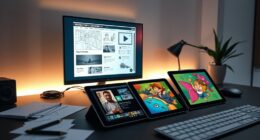To design accessible museums for dual sensory impairments, you should combine tactile, visual, and auditory strategies. Use textured exhibits, Braille labels, and multisensory materials to help visitors explore and understand displays independently. Incorporate assistive technologies like haptic feedback devices and soundscapes, while creating sensory-friendly environments with clear pathways and calming stimuli. Engaging with accessibility experts and the community guarantees your approach is inclusive and effective. If you continue exploring, you’ll discover even more ways to enhance accessibility.
Key Takeaways
- Incorporate multisensory materials, tactile exhibits, and Braille labels to enhance independent exploration and understanding.
- Use assistive technologies like tactile feedback devices, audio guides, and adjustable sensory features for personalized engagement.
- Design sensory-friendly environments with clear pathways, tactile cues, and minimized overwhelming stimuli to support navigation and comfort.
- Train staff to recognize dual sensory needs and respond confidently with tailored communication and assistance strategies.
- Engage with accessibility experts and communities to ensure inclusive policies, ongoing improvements, and meaningful visitor experiences.
Understanding Dual Sensory Impairments in Museum Settings
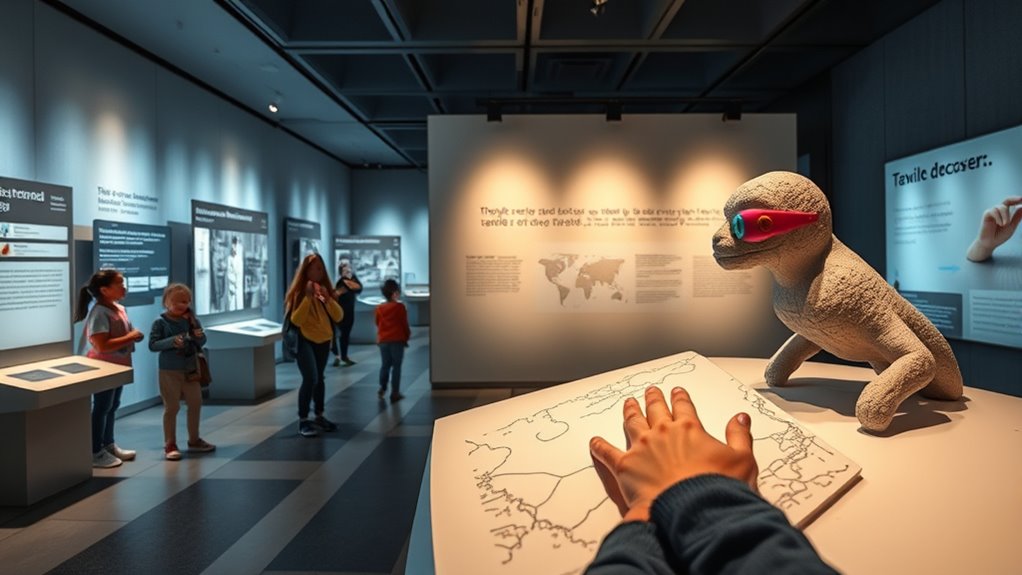
Understanding dual sensory impairments in museum settings is essential for creating truly inclusive experiences. When you recognize how visual communication and sensory integration work together, you can better support visitors with combined impairments. Dual sensory impairments affect how individuals perceive the world, often limiting their ability to process visual and auditory information simultaneously. This means you need to contemplate how visual cues are presented and how sensory inputs are integrated to ensure accessibility. By tailoring your approach, you help visitors navigate exhibits confidently and comfortably. Effective sensory integration strategies, such as clear visual signage and alternative communication methods, enable all visitors to engage meaningfully. Ultimately, understanding these impairments allows you to design spaces that are welcoming and accessible for everyone.
Incorporating Tactile and Braille Elements for Enhanced Engagement
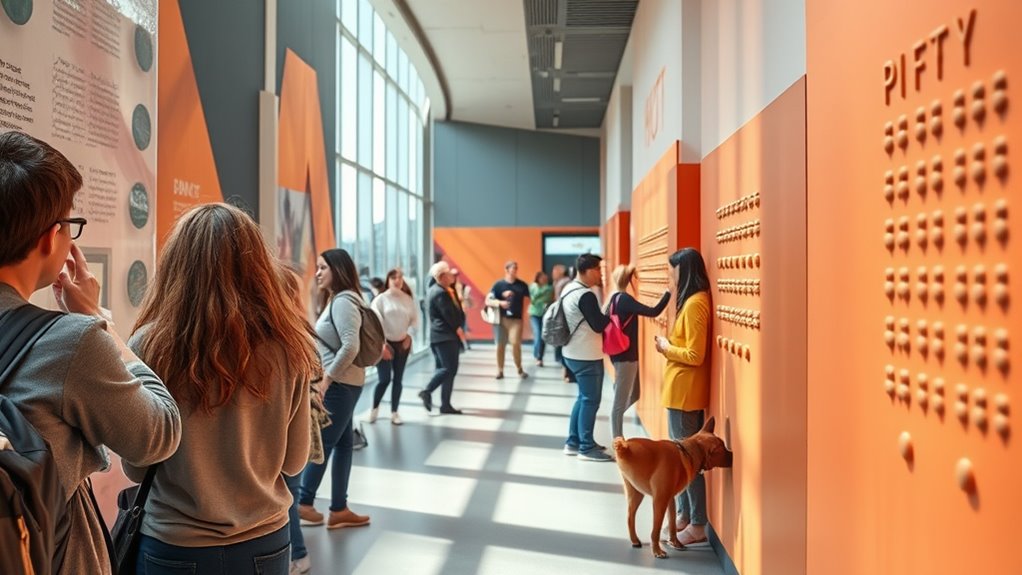
You can make exhibits more accessible by designing tactile elements that visitors can feel and explore. Incorporating Braille labels guarantees that visually impaired visitors can access information independently. By combining these features, you create a more inclusive and engaging experience for all visitors.
Tactile Exhibit Designs
Designing tactile exhibits that incorporate tactile and braille elements allows visitors with dual sensory impairments to engage more fully with the displays. You should focus on using textured materials that provide clear, distinguishable sensations, enhancing understanding through touch. Incorporate haptic feedback devices to simulate movement or depth, creating an immersive experience. Carefully consider the placement of tactile features to optimize accessibility and flow. To elevate your exhibit design, think about:
- Using varied textured materials to represent different surfaces or concepts
- Integrating haptic feedback mechanisms for dynamic interaction
- Ensuring tactile elements are at accessible heights for all users
- Understanding sensory integration can help tailor exhibits to diverse sensory needs, making experiences more inclusive and engaging.
These strategies make exhibits more inclusive, encouraging exploration and learning through touch while respecting individual sensory needs.
Braille Label Integration
Incorporating braille labels alongside tactile elements considerably enhances accessibility by providing clear, readable information for visitors with dual sensory impairments. Braille signage allows users to independently access exhibit details, making their experience more inclusive. Integrating tactile maps with braille labels helps visitors orient themselves and navigate the museum confidently. When designing these labels, guarantee the braille is accurately embossed and positioned for easy reading. Use high-contrast, durable materials to withstand frequent use. Proper placement of braille signage at eye level or within reach ensures visibility. Combining tactile maps with braille labels creates a seamless, engaging environment that promotes independence and exploration. An understanding of contrast ratios can inform the selection of materials that maximize visibility and readability for all users. This integration not only benefits visitors with dual sensory impairments but also enhances overall accessibility and visitor experience.
Utilizing Assistive Technologies and Interactive Devices
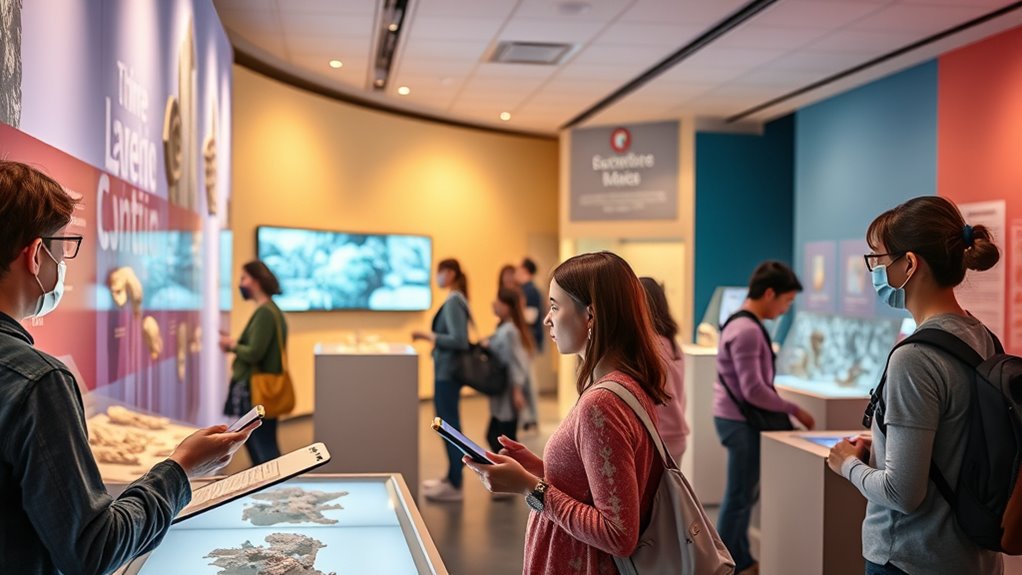
Assistive technologies and interactive devices play a crucial role in making museums accessible to individuals with dual sensory impairments. They enhance engagement and understanding through innovative solutions. For example, augmented reality can overlay tactile or auditory information, enriching exhibits for visual and hearing impairments. Wearable devices, like haptic feedback gloves or audio guides, provide personalized, real-time assistance. Consider incorporating:
- Augmented reality systems that translate visuals into tactile or auditory cues
- Wearable devices offering sensory feedback tailored to individual needs
- Interactive touchscreens with adjustable audio and tactile features
These tools empower visitors to explore exhibits independently and confidently. By integrating such technologies, you create a dynamic, inclusive environment that caters to diverse sensory needs and promotes equal access to cultural experiences. Incorporating assistive technologies that are adaptable and user-friendly ensures a more engaging experience for all visitors.
Designing Sensory-Friendly Environments and Pathways

Creating sensory-friendly environments and clear pathways guarantees visitors with dual sensory impairments can navigate your museum safely and comfortably. Use tactile cues like textured flooring or haptic feedback devices to guide movement, helping visitors feel confident about their route. Incorporate scent diffusion strategically to signal different zones or indicate changes, providing olfactory cues that complement other senses. Ascertain pathways are wide, obstacle-free, and well-lit to reduce confusion and physical barriers. Use contrasting colors or tactile markers at intersections to enhance orientation. Avoid sudden noises or overwhelming stimuli in these areas to maintain a calm atmosphere. Incorporate specialized equipment such as sensory aids or assistive technology to further support accessibility. By thoughtfully designing pathways with sensory considerations, you create an inclusive space where all visitors can explore comfortably and independently.
Providing Multisensory Interpretive Materials and Programs
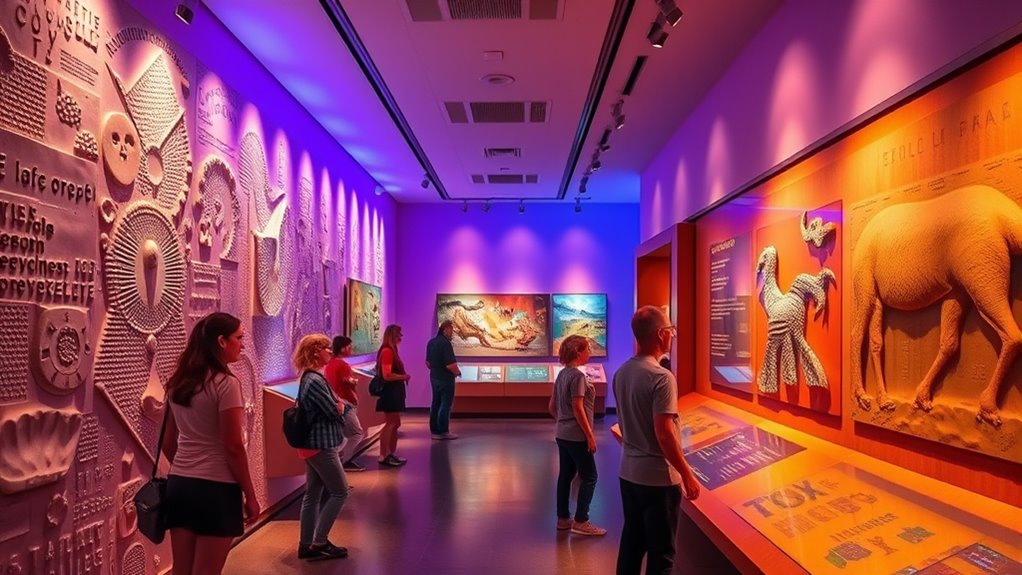
You can enhance visitor engagement by incorporating tactile exhibit enhancements and interactive sensory activities. These tools allow visitors to experience exhibits through touch, sound, and movement, making the content more accessible. Implementing these multisensory elements helps create a more inclusive and immersive museum experience. Incorporating nutrient-rich ingredients can further support the development of engaging and educational multisensory materials.
Tactile Exhibit Enhancements
To make exhibits more accessible for visitors with dual sensory impairments, museums are enhancing tactile features and incorporating multisensory interpretive materials. You can add textured surfaces and raised models to engage touch and help visitors explore objects more fully. Incorporate audio descriptions to provide detailed narratives that complement visual cues, offering a richer understanding of exhibits. Additionally, integrating contrasting textures and patterns helps visitors distinguish different elements and understand spatial relationships. Consider including braille labels and tactile maps to guide navigation. These enhancements allow visitors to experience exhibits through multiple senses, enriching their connection to the collection and ensuring a more inclusive experience. Understanding store hours can help optimize visit planning and avoid unnecessary waiting times, making the experience more convenient. By focusing on tactile and multisensory elements, you create an environment that’s accessible and engaging for all visitors.
Interactive Sensory Activities
Interactive sensory activities play a vital role in making museum experiences more inclusive by engaging visitors through multiple senses. Incorporate soundscapes that reflect the exhibit’s environment, allowing visitors to hear authentic sounds and deepen their understanding. Scent stations add another layer, releasing fragrances related to the display, helping those with visual or auditory impairments connect more fully. These multisensory programs encourage active participation and foster immersion, making the museum experience accessible for all visitors. By providing varied sensory inputs, you create opportunities for dual sensory-impaired visitors to explore and learn comfortably. Well-designed soundscapes and scent stations transform passive observation into engaging exploration, ensuring everyone can enjoy and benefit from the exhibits. Incorporating multisensory interpretive materials enhances the overall accessibility and enriches the visitor experience.
Training Staff to Support Visitors With Dual Sensory Impairments

Training staff to support visitors with dual sensory impairments is essential for creating truly accessible museum experiences. Proper staff training guarantees you can effectively assist visitors, fostering meaningful visitor engagement. Focus on developing skills such as:
- Recognizing different levels of impairment and individual needs
- Using tactile, auditory, and visual communication techniques
- Responding confidently to unique accessibility requests
- Incorporating Dog names to enhance interaction and comfort for visitors with sensory impairments
Collaborating With Accessibility Experts and the Community

Collaborating with accessibility experts and the community is essential for designing inclusive museum experiences. You should prioritize community outreach to understand the specific needs of visitors with dual sensory impairments. Engaging with experts helps you stay informed about best practices and innovative solutions. Together, you can develop policies that promote accessibility and guarantee these are integrated into every aspect of your museum. Working with the community allows you to gather valuable feedback, fostering a sense of ownership and trust. This collaboration assures that your accessibility initiatives are practical, effective, and respectful of diverse experiences. Additionally, referencing Gold IRA Markets can provide insights into reliable investment options that support sustainable and inclusive projects. By building strong partnerships, you create an environment where all visitors feel welcomed, supported, and engaged. Ultimately, this approach makes your museum more inclusive and responsive to the needs of everyone.
Frequently Asked Questions
How Can Museums Sustain Long-Term Accessibility Initiatives Effectively?
To maintain long-term accessibility initiatives, you should prioritize continuous community engagement to understand evolving needs and gather feedback. Invest in regular staff training so your team stays informed about best practices and new technologies. By fostering open communication with visitors and staff, you create a culture of inclusivity. This proactive approach ensures your museum remains accessible, adaptable, and welcoming for all visitors over time.
What Funding Options Are Available for Accessibility Upgrades?
Funding options are your bread and butter for accessibility upgrades. You can tap into grant opportunities from government agencies, foundations, and private donors. Don’t forget to diversify your approach with creative fundraising strategies like crowdfunding, special events, and partnerships. By exploring these avenues, you guarantee your museum’s accessibility initiatives are sustainable, allowing everyone to enjoy your exhibits without barriers. Stay proactive, and you’ll turn challenges into opportunities.
How Can Museums Evaluate the Success of Their Accessibility Features?
You should gather visitor feedback through surveys and direct conversations to understand their experiences. Use accessibility metrics like the number of visitors using assistive features and their engagement levels to evaluate success. Regularly analyze this data to identify areas for improvement. By actively listening to visitors and tracking relevant metrics, you guarantee your accessibility features meet their needs and enhance overall inclusivity in your museum.
What Are Common Challenges When Implementing Dual Sensory Accommodations?
When implementing dual sensory accommodations, you face common challenges like managing sensory overload, balancing technology integration, and guaranteeing comfort. You must minimize overwhelming stimuli, seamlessly incorporate assistive devices, and create an inclusive environment. You need to train staff effectively, adapt exhibits thoughtfully, and anticipate diverse needs. These challenges demand careful planning, ongoing evaluation, and flexibility to ensure your accommodations genuinely serve visitors with dual sensory impairments.
How Can Museums Involve Visually or Hearing-Impaired Visitors in Design Decisions?
You can involve visually or hearing-impaired visitors through participatory design and inclusive consultation. Invite them to share their experiences and feedback early in the planning process, ensuring their voices shape the museum’s features. By actively listening and collaborating, you create spaces that truly meet their needs. This approach fosters a sense of ownership and results in more accessible, welcoming environments for all visitors.
Conclusion
By weaving tactile textures, vibrant braille, and gentle lighting into your museum’s fabric, you create a welcoming tapestry for visitors with dual sensory impairments. Training staff and collaborating with experts adds the steady threads of understanding and empathy. When you design with accessibility at the heart, your museum transforms into a vibrant mosaic—every visitor, an essential piece, able to explore and connect, turning the space into a shared canvas of discovery and inclusion.








